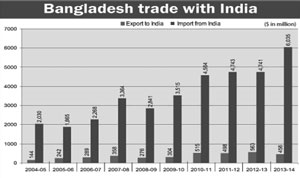
Bangladesh has a close trade relationship with neighbouring India, the country that helped us achieve Independence in 1971. But unfortunately, the trade gap between the two countries has all through been increasing in favour of India. The battle of Bangladesh to narrow the gap is getting tougher day by day. There are various economic and political factors behind this trade deficit going against Bangladesh. What is urgently needed at present is to minimise or close the export-import gap between the two countries. To this end, Bangladesh needs to be provided with a more favourable environment and opportunities so that it can enhance its exports to India.
Experts, economists, bureaucrats, regulators and business leaders opine that despite the diverse trade barriers, Bangladesh can enhance exports to the big neighbour by building the capacity of the exporters. And building institutional capabilities and training up new exporters should be supportive to those initiatives. A comprehensive trade agreement between Bangladesh and India is also necessary for resolving the non-conforming sanitary and phytosanitary (SPS) measures that undermine trade potential of the two neighbouring countries, especially in agricultural commodity exports. The SPS measures like laboratory testing and certification of food and agricultural products have emerged as non-tariff barriers (NTBs) in the absence of a comprehensive agreement and appropriate mechanisms and initiatives to deal with the SPS concerns.
The debate also remains over whether Bangladesh could grab a greater share of the Indian market amidst the SPS concerns and other NTBs. Under the circumstances, the capacity building of exporters would be a catalyst for Bangladesh to reduce the trade gap with India by increasing exports. The data of the Export Promotion Bureau (EPB) shows the bilateral trade between Bangladesh and India has remained highly favourable to India. In 2014 Bangladesh exported US$ 456 million worth of goods against its imports worth US$ 6.1 billion from India. Some experts believe that the higher import from India is in fact beneficial to Bangladesh as most of the imports were raw materials or intermediate goods for producing goods for exports or for meeting the domestic demand at competitive prices.
However, there needs to be a level playing field so that Bangladesh can increase its exports to India without facing tariff and non-tariff barriers. The barriers should be taken into account seriously both at the business and political levels. That would surely be beneficial to both Bangladesh and India. Official sources say Bangladesh government is trying to solve the trade-related issues, as a result of which exports to India witnessed an upward trend in the recent years.
Referring to the World Trade Organisation (WTO), the government sources say the SPS agreement allows countries to set their own standards. But those must be based on science and should not be arbitrary or unjustifiably discriminating between countries where identical or similar conditions prevail. It is also presumed that Bangladesh can increase exports to India by availing the duty-free and quota-free (DF-QF) market access offered by New Delhi and by increasing the capacity of exporters. Government sources also say Bangladesh's export to India is not expanding significantly due to the lack of capacity-building of exporters. The second impediment is the absence of institutional strengthening and the third is the lack of product diversification for exports. It should be underlined that Bangladesh needs to particularly go for institutional capacity-building, because India is a very important trade partner.
However, it is very important that organisations like the Bangladesh Standards and Testing Institution (BSTI) are required to go for institutional capacity building. There are also a number of on-the-spot concerns for Bangladeshi exporters. They have to wait for approval of the Central Food Laboratory (CFL) of India before delivery of their consignments of exports to India. All food samples are sent to Kolkata which is around 400-500 kilometres away from Dhaka as the CLF facility is not available anywhere near the land ports.
There is no universal standard for food and agro-based trade items. The problems may continue to exist without a mutually-agreeable standard. In this connection the Bangladesh Accreditation Board (BAB) says any certification issued by the BAB should be accepted in all countries. In reality, the Indian customs does not accept the accreditation certificates issued by any laboratory other than the Indian ones. The governments of the two countries should settle these issues. It is also suggested that an administrative system is needed to maintain the hygienic standard and quality of perishable agro-products being exported.
The Export Promotion Bureau (EPB) should educate the exporters on certification and compliance issues. In fact, the macro issues, such as certification and lab facility have remained the same for decades, but some micro issues have improved. However, policy recommendations have very little impact on the ground reality. Bangladeshi exporters feel that certification and testing-related requirements in the Indian market for agro and food products create problems for exporters. The Dhaka Chamber of Commerce and Industry (DCCI) says it looks forward to positive developments relating to the conflicting policies.
Bangladesh-India trade matters should be viewed more from the fair economic perspective than from political perspective so that Bangladesh may narrow down the big trade deficit with India.
The writer is a retired professor of Economics, BCS General
Education Cadre.
© 2024 - All Rights with The Financial Express
